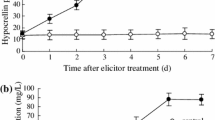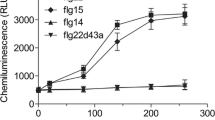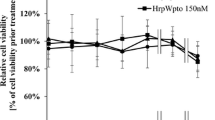Abstract
In this study, the oligoguluronate elicitor-induced oxidative burst (OB) was monitored continuously in young and mature Saccharina japonica sporophytes based on luminol chemiluminescence using a photon counter. The iodoperoxidase (IPO) activity, abscisic acid (ABA), and polyphenol contents were also compared in the different growth stages. The elicitor-induced OB occurred within 1 min and reached its maximum in 15–20 min after treatment in all growth stages. The active elicitor-induced OB was stronger in the young sporophytes than the older sporophytes. The IPO activity in the different growth stages also exhibited a similar pattern to the elicitor-induced OB. These results suggest that the elicitor-induced OB and the subsequent high haloperoxidase activity comprise a major defence mechanism in young sporophytes. By contrast, ABA accumulated with the growth of the sporophytes. Interestingly, ABA treatment suppressed the elicitor-induced OB during growth and enhanced the elicitor-independent IPO activity even in the young sporophytes. In addition, the polyphenol content was higher in the older sporophytes than the younger sporophytes. These observations show that dramatic changes occur in the characteristic defences against biotic stresses as the sporophyte grows, as well as suggesting that ABA is closely linked with these changes. Moreover, the IPO activity recovered slightly in the sorus, which is the reproductive tissue, thereby suggesting that a higher ABA content increases the defence activity and the success of reproduction.




Similar content being viewed by others
References
Almeida M, Humanes M, Melo R, Silva JA, Fraústo da Silva JJR, Vilter H, Wever R (1998) Saccorhiza polyschides (Phaeophyceae: Phyllariaceae) a new source for vanadium-dependent haloperoxidases. Phytochemistry 48:229–239
Almeida M, Filipe S, Humanes M, Maia MF, Melo R, Severino N, Silva JA, Fraústo da Silva JJR, Wever R (2001) Vanadium haloperoxidases from brown algae of the Laminariaceae family. Phytochemistry 57:633–642
Ar Gall E, Küpper FC, Kloareg B (2004) A survey of iodine content in Laminaria digitata. Bot Mar 47:30–37
Bassaganya-Riera J, Guri AJ, Lu P, Climent M, Carbo A, Sobral BW, Horne WT, Lewis SM, Bevan DR, Hontecillas R (2011) Abscisic acid regulates inflammation via ligand-binding domain-independent activation of peroxisome proliferator-activated receptor γ. J Biol Chem 286:2504–2516
Berglin M, Delage L, Potin P, Vilter H, Elwing H (2004) Enzymatic cross-linking of a phenolic polymer extracted from the marine alga Fucus serratus. Biomacromolecules 5:2376–2383
Bitton R, Berglin M, Elwing H, Colin C, Delage L, Potin P, Bianco-Peled H (2007) The influence of halide-mediated oxidation on algae-born adhesives. Macromol Biosci 7:1280–1289
Borchardt SA, Allain EJ, Michels JJ, Stearns GW, Kelly RF, McCoy WF (2001) Reaction of acylated homoserine lactone bacterial signaling molecules with oxidized halogen antimicrobials. Appl Environ Microbiol 67:3174–3179
Clay NK, Adio AM, Denoux C, Jander G, Ausubel FM (2009) Glucosinolate metabolites required for an Arabidopsis innate immune response. Science 323:95–101
Estes JA, Tinker MT, Williams TM, Doak DF (1998) Killer whale predation on sea otters linking oceanic and nearshore ecosystems. Science 282:473–476
Estes JA, Danner EM, Doak DF, Konar B, Springer AM, Steinberg PD, Tinker MT, Williams TM (2004) Complex trophic interactions in kelp forest ecosystems. Bull Mar Sci 74:621–638
Graham TL, Graham MY (1996) Signaling in soybean phenylpropanoid responses (dissection of primary, secondary, and conditioning effects of light, wounding, and elicitor treatments). Plant Physiol 110:1123–1133
Guajardo E, Correa JA, Contreras-Porcia L (2016) Role of abscisic acid (ABA) in activating antioxidant tolerance responses to desiccation stress in intertidal seaweed species. Planta 243:767–781
Harrison PJ, Druehl LD (1982) Nutrient uptake and growth in the Laminariales and other macrophytes: a consideration of methods. In: Srivastava LM (ed) Synthetic and degradative processes in marine macropphytes. Walter de Gruyter, Berlin, pp 99–120
Harrison PJ, Druehl LD, Lloyd KE, Thompson PA (1986) Nitrogen uptake kinetics in three year-classes of Laminaria groenlandica (Laminariales: Phaeophyta). Mar Biol 93:29–35
Hatung W (2010) The evolution of abscisic acid (ABA) and ABA function in lower plants, fungi and lichen. Funct Plant Biol 37:806–812
Haug A, Larsen B, Smidsrod O (1974) Uronic acid sequence in alginate from different sources. Carbohydr Res 32:217–225
Heo SJ, Park EJ, Lee KW, Jeon YJ (2005) Antioxidant activities of enzymatic extracts from brown seaweeds. Bioresour Technol 96:1613–1623
Hosoya T (1963) Effect of various reagents including antithyroid compounds upon the activity of thyroid peroxidase. J Biochem 53:381–388
Hotter GS (1997) Elicitor-induced oxidative burst and phenylpropanoid metabolism in Pinus radiata cell suspension cultures. Aust J Plant Physiol 23:797–804
Ishikawa Y, Saga N (1989) The diseases of economically valuable seaweeds and pathology in Japan. Fuji Technology Press, Tokyo, pp 215–218
Kanamori M, Mizuta H, Yasui H (2012) Effects of ambient calcium concentration on morphological form of callus-like cells in Saccharina japonica (Phaeophyceae) sporophyte. J Appl Phycol 24:701–706
Küpper FC, Kloareg B, Guern J, Potin P (2001) Oligoguluronates elicit an oxidative burst in the brown algal kelp Laminaria digitata. Plant Physiol 125:78–291
Küpper FC, Müller DG, Peters AF, Kloareg B, Potin P (2002) Oligoalginate recognition and oxidative burst play a key role in natural and induced resistance of sporophytes of Laminariales. J Chem Ecol 28:2057–2081
Küpper FC, Carpenter LJ, Mcfiggans GB, Palmer CJ, Waite TJ, Boneberg EM, Woitsch S, Weiller M, Abela R, Grolimund D, Potin P, Butler A, Luther IIIGW, Kroneck PMH, Meyer-Klaucke W, Feiters MC (2008) Iodide accumulation provides kelp with an inorganic antioxidant impacting atmospheric chemistry. Proc Natl Acad Sci 105:6954–6958
Kusajima M, Yasuda M, Kawashima A, NojiriH YH, Nakajima M, Akutsu K, Nakashita H (2010) Suppressive effect of abscisic acid on systemic acquired resistance in tabacco plants. J Gen Plant Pathol 76:161–167
Lane CE, Mayes C, Druehl LD, Saunders GW (2006) A multi-gene molecular investigation of the kelp (Laminariaes, Phaeophyceae) supports substantial taxonomic re-organization. J Phycol 42:493–512
Launchbaugh K, Howery LD (1993) Grazing management and ecology. Ecology 74:271–272
Mann KH (1973) Seaweeds: their productivity and strategy for growth. Science 182:975–981
Mauch-Mani B, Mauch F (2005) The role of abscisic acid in plant-pathogen interactions. Curr Opin Plant Biol 8:409–414
Mehrtens G (1994) Haloperoxidase activities in Arctic macroalgae. Polar Biol 14:351–354
Mizuta H, Yasui H (2010) Significance of radical oxygen production in sorus development and zoospore germination in Saccharina japonica (Phaeophyceae). Bot Mar 53:409–416
Nimura K, Mizuta H (2002) Inducible effects of abscisic acid on sporophyte discs from Laminaria japonica Areschoug (Laminariales, Phaeophyceae). J Appl Phycol 14:159–163
Palmer CJ, Anders TL, Carpenter LJ, Küpper FC, McFiggans G (2005) Iodine and halocarbon response of Laminaria digitata to oxidative stress and links to atmospheric new particle production. Environ Chem 2:282–290
Pavia H, Toth GB (2000) Inducible chemical resistance to herbivory in the brown seaweed Ascophyllum nodosum. Ecology 81:3212–3225
Peng Y, Li W (2013) A bacterial pathogen infecting gametophytes of Saccharina japonica (Laminariales, Phaeophyceae). Chin J Oceanol Limnol 31:366–373
Provasoli L (1968) Media and prospects for the cultivation of marine algae. In: Watanabe A, Hattori A (eds) Culture and collections of algae, Proc. U. S. -Japan Conf., Hakone, September 1966. Jpn. Soc. Plant Physiol., Tokyo, 63–75
Saradhi PP, Suzuki I, Katoh A, Sakamoto A, Sharmila P, Shi DJ, Murata N (2000) Protection against the photo-induced inactivation of the photosystem II complex by abscisic acid. Plant Cell Environ 23:711–718
Sawabe T, Makino H, Tatsumi M, Nakano K, Tajima K, Iqbal MM, Yumoto I, Ezura Y, Christen R (1998) Pseudoalteromonas bacteriolytica sp. nov., a marine bacterium that is the causative agent of red spot disease of Laminaria japonica. Int J Syst Evol Microbiol 48:769–774
Schaffelke B (1995a) Abscisic acid in sporophytes of three Laminaria species (Phaeophyta). J Plant Physiol 146:453–458
Schaffelke B (1995b) Storage carbohydrates and abscisic acid contents in Laminaria hyperborea are entrained by experimental daylengths. Eur J Phycol 30:313–317
Senevirathne M, Kim SH, Siriwardhana N, Ha JH, Lee KW, Jeon YY (2006) Antioxidant potential of Ecklonia cava on reactive oxygen species scavenging, metal chelating, reducing power and lipid peroxidation inhibition. Food Sci Technol Int 12:27–28
Shinozaki K, Shinozaki KY, Seki M (2003) Regulatory network of gene expression in the drought and cold stress responses. Curr Opin Plant Biol 6:410–417
Steinberg PD (1984) Algal chemical defense against herbivores: allocation of phenolic compounds in the kelp Alaria marginata. Science 223:405–407
Teas J, Pino S, Critchley A, Braverman LE (2004) Variability of iodine content in common commercially available edible seaweeds. Thyroid 14:836–841
Thomas F, Cosse A, Goulitquer S, Raimund S, Morin P, Valero M, Leblanc C, Potin P (2011) Waterborne signaling primes the expression of elicitor-induced genes and buffers the oxidative responses in the brown alga Laminaria digitata. PLoS One 6:e21475
Thomas F, Cosse A, Panse SL, Kloareg B, Potin P, Leblanc C (2014) Kelps feature systemic defense responses: insights into the evolution of innate immunity in multicellular eukaryotes. New Phytol 204:567–576
Tucker DJ, Mansfield TA (1971) A simple bioassay for detecting “antitranspirant” activity of naturally occurring compounds such as abscisic acid. Planta 98:157–163
Wang G, Shuai L, Li Y, Lin W, Zhao X, Duan D (2008) Phylogenetic analysis of epiphytic marine bacteria on hole-rotten disease sporophytes of Laminaria japonica. J Appl Phycol 20:403–409
Wever R, Tromp MG, Krenn BE, Marjani A, Van Tol M (1991) Brominating activity of the seaweed Ascophyllum nodosum: impact on the biosphere. Environ Sci Technol 25:446–449
Wheeler WN (1980) Pigment content and photosynthetic rate of the fronds of Macrocystis pyrifera. Mar Biol 56:97–102
Yoshida K, Igarashi E, Mukai M, Hirata K, Miyamoto K (2003) Induction of tolerance to oxidative stress in the green alga, Chlamydomonas reinhardtii, by abscisic acid. Plant Cell Environ 26:451–457
Yoshida K, Igarashi E, Wakatsuki E, Miyamoto K, Hirata K (2004) Mitigation of osmotic and salt stresses by abscisic acid through reduction of stress-derived oxidative damage in Chlamydomonas reinhardtii. Plant Sci 167:1335–1341
Acknowledgements
We sincerely thank Mr. Ikuya Miyajima of Usujiri Fisheries Station, Field Science Center, Hokkaido University for helping with the cultivation of kelps during our study.
Funding
This study was supported partly by a Grant-in-Aid for Scientific Research from the Japan Society for the Promotion of Science (no. 25450268).
Author information
Authors and Affiliations
Corresponding author
Rights and permissions
About this article
Cite this article
Shimizu, K., Uji, T., Yasui, H. et al. Control of elicitor-induced oxidative burst by abscisic acid associated with growth of Saccharina japonica (Phaeophyta, Laminariales) sporophytes. J Appl Phycol 30, 1371–1379 (2018). https://doi.org/10.1007/s10811-017-1320-2
Received:
Revised:
Accepted:
Published:
Issue Date:
DOI: https://doi.org/10.1007/s10811-017-1320-2




